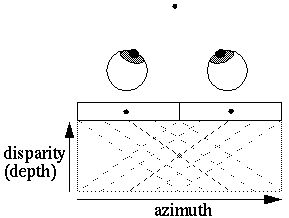Plato's Cave: Binocular Bubble
The Binocular Bubble Model
In the binocular case, the Bubble Model invokes the Projection
Field Theory to reconstruct the depth dimension. The primary
visual cortex is divided into ocular dominance columns, parallel
strips in which cells respond primarily to input from the left or
right eye in an alternating pattern. The figure below represents a
single feature, the dot, seen binocularly, which produces an image of
that dot on adjacent occular dominance columns represented by the two
rectangles in the figure.

The depth information can be recovered from these two monocular views
by projecting the left and right images through each other at an
angle, as shown by the grey dashed lines above, and the depth of any
feature is found at the point where the left and right projections of
that feature meet. In a neural network model this projection could be
performed by a matrix of neural tissue with synaptic connections
parallel to the projection lines, so that for example the gray cell
depicted at the center of this tissue above marks the point where the
input from the left eye projected along the slanting dashed lines to
the left, crosses that from the right eye along the slanting dashed
lines to the right, resulting in a percept of the feature in depth at
the location where the two projections cross.
The Bubble Model shows how this mechanism designed for binocular depth
perception can also serve for reconstruction of depth in the monocular
case making use of the same matrix of tissue. The boundary and
surface completion operations essential to such monocular
reconstruction would serve equally well to refine the percept and
resolve ambiguities in the binocluar percept too .
Return to argument
Return to Steve Lehar

